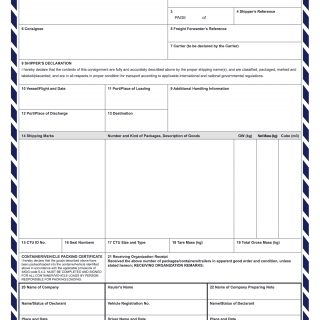IMO Dangerous Goods Declaration
The IMO Dangerous Goods Declaration is a form used to declare the contents of a shipment containing dangerous goods. The main purpose of this form is to ensure the safety of everyone involved in the transportation of these dangerous goods, as well as the environment.
The form consists of several parts, including the shipper's name and address, the consignee's name and address, the carrier's name and address, and the UN number and proper shipping name of the dangerous goods being transported. Other important fields on the form include the packing group, flashpoint, and quantity of dangerous goods being shipped.
The parties involved in the form include the shipper, consignee, and carrier. It is important to consider the regulations and guidelines set forth by the International Maritime Organization (IMO) and other governing bodies when writing the form. This includes accurately identifying the dangerous goods being shipped and properly packaging them for transportation.
Data that will be required when writing the form includes the name and address of the shipper and consignee, the proper shipping name and UN number of the dangerous goods being shipped, and the quantity and packaging of the dangerous goods. Additionally, supporting documents such as Material Safety Data Sheets (MSDS) may need to be attached.
Application examples and practice and use cases for the form include shipping hazardous materials such as chemicals, batteries, and compressed gases. Strengths of the form include its ability to ensure the safety of everyone involved in the transportation of dangerous goods. Weaknesses may include the potential for errors in identifying and declaring the contents of a shipment, which can lead to delays and fines. Opportunities for improvement may include the use of electronic forms to streamline the declaration process.
Related and alternative forms include the International Air Transport Association (IATA) Dangerous Goods Declaration, the International Civil Aviation Organization (ICAO) Technical Instructions for the Safe Transport of Dangerous Goods by Air, and the United States Department of Transportation (DOT) Hazardous Materials Shipping Papers. The differences between these forms may include variations in regulations and guidelines for different modes of transportation.
The form affects the future of the participants by ensuring the safe transport of dangerous goods and avoiding potential accidents or environmental damage. The form is typically submitted to the carrier for review and may be stored electronically or in paper form for future reference.

